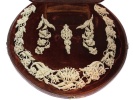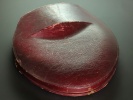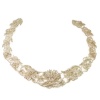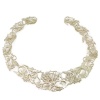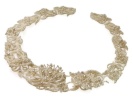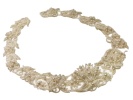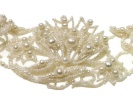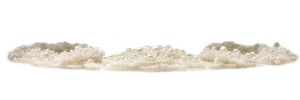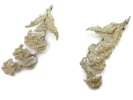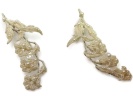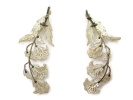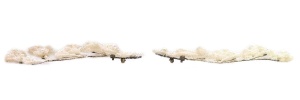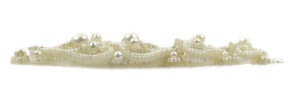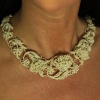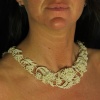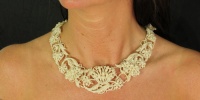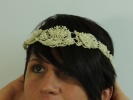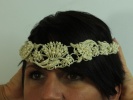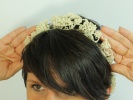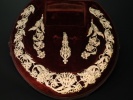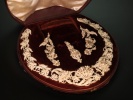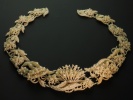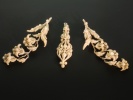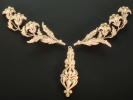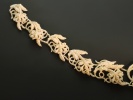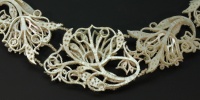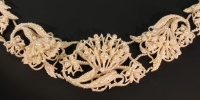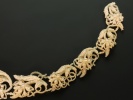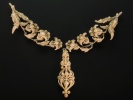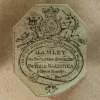We offer layaway, spread payments on the piece of your dreams. Ask us for details. Free insured shipping on all orders !!!
Georgian woven natural seed pearl parure necklace pendant brooches pre Victorian
Here we have what we call in our trade, a parure. A parure is a matching set of jewellery pieces, meant to be worn together. Consisting of an immense amount of natural seed pearls in the finest condition sewn on mother of pearl, this specific Georgian
parure from 1810 is a delicate beauty.
Waiting to be discovered by you when opening the original treasure box, signed "Hamlet Goldsmith & Jeweller To Their Majesties & Royal Family, Princes Street Leicester Square", there's a pearl wreath of lilies meant as a necklace or tiara, a pearl
pendant out of four triple lobed frills and two pearl branches with three lilies as a part of a brooch or tiara. Although these jewels haven't got their usual closures, they have the potential to make you a princess of earth and sea by crafting those
necessities with respect to the purity of the silky gloss of the lilies.
Antique jewelry object group: parure - a parure is a 'matching set of various type of jewelry' and in this case it
consist out of a necklace, brooches or parts of a parure and a pendant.
It comes in its original box where we can see that the necklace, without a closure, is meant to be like that. Most likely it
was sewn to clothing or as part of a tiara. We didn't want to change that but if necessary we can add a sort of closure to the back to make it
wearable as a necklace.
Besides the necklace there are also two slightly bowed shapes (that we think were either parts of a tiara or brooches) and a
pendant.
Also notable that in the box some parts are missing. Most likely a hair comb (to hold the brooches?) and a brooch system.
Condition: excellent condition
- (more info on our condition scale)
Country of origin:
Although it does not carry any legible control marks we believe this to be of British origin.
Style:
Georgian - Georgian style is the name given in most English-speaking countries to the set of styles current between 1720 and 1840. It is eponymous for the first four British monarchs of the House of Hanover—George I of Great Britain, George II of Great
Britain, George III of the United Kingdom, and George IV of the United Kingdom—who reigned in continuous succession from August 1714 to June 1830.
- See also: Georgian
or more info on styles
Style specifics: Seed pearl jewelry Georgian period 1714-1830
- Natural seed pearls (smaller than 2mm and not completly round) were an essential part in Georgian jewelry. They were made
into long tasselled sautoirs, or threaded into intricate designs to support slides and clasps, or used as surrounds for
gemstones, cameo's, micro mosaics, instead of the more traditional diamonds. Particularly exquisite are the parures of seed pearls in various sizes, sewn by hand on to a drilled
mother-of-pearl backing to create necklaces, hair ornaments and earrings of delicate beauty. Occasionally these are set
with gemstone-mounted centres.
Period: ca. 1810
- (events and facts in 1810)
Material:
- (more info on precious metals)
Technique: seed pearls sewn on mother of pearl
Due to the size of the seed pearls, special care and patience was needed when drilling the holes, as a even the smallest mistake would result in the loss of value or render the pearl completely useless. It was an art Indian lapidaries where especially
famed for, due to the extensive use of seed pearls in traditional Indian jewelry.
For all its fragility, a good deal of seed pearl work has survivied and fine examples in boxed sets can still be found.
Pearls have always had a beautifying effect on women. From the book "Georgian Jewellery 1714 1830" (where on page 153 you can
see some jewelry that comes from the Adin collection)
Source of inspiration: Purity and innocence are characteristics often ascribed to pearls, combined with the purity attributed to the lily depicted in the necklace, made them an ideal wedding gift for a blushing bride.
The well known story of Egyptian Queen Cleopatra, dissolving a pearl into vinegar and drinking it to showcase her wealth to Caesar is often disregarded as myth. But there are records of Ranjit Singh, a nineteenth century party loving Indian prince who
threw decadent parties where he would ground pearls to a powder and mix them with wine to offer to his favored guests to impress them. We don't suggest giving this necklace the Cleopatra nor the Ranjit Singh treatment, just wearing it will suffice to
impress your friends.
Extra information:
Georgian period 1714-1830 - Georgian jewellery
refers to jewellery made during the years when the four King Georges ruled Great Britain. Georgian jewellery encompassed most of the 18th century and the beginning of the 19th century.
Ornate gold work in the form of cannetille, with its intricate designs of tendrils, scrolls and granulation became widely popular around 1830. Gemstones
were close-backed with colored foils
mounted behind them to enhance the color. Diamonds
were set with silver-topped gold to emphasize their whiteness. Enameling
was another important decorative element. Cobalt blue enamel was often used in combination with diamonds. Neoclassical
motifs proliferated: Greek key, urns, plumes and acorns. Fashionable styles included long drop earrings, necklaces composed of plaques joined by gold chains, rivières, bracelets worn in pairs, and large finger rings. Long gold muff chains of
textured, round links came into fashion towards the end of this period.
During the early Georgian period (George I, 1714-1727), the French Rococo style dominated the arts. There wasn't a specific individual British style of jewellery during this period, like there was in the Victorian period
. The jewellery of this period consisted largely of nature pieces, including designs with birds, flowers, leaves, insects, and feathers. They were delicate and light, and many were set on a spring so that they trembled. Those pieces set with precious
gemstones were very unique-they were entirely handmade. Most pieces were encrusted with gemstones, and the type of metal used to create pieces was of secondary importance. The most popular motifs of this time for diamonds were baskets of flowers, spurts
of foliage, and feather plumes. During the Georgian period, jewellery pieces with less precious gemstones were also produced in greater quantities, using coral, garnets, turquoise, and even paste.
Precious stones:
an uncountable amount of seed pearls
- (more info on precious stones)
Birthstones:
Pearl is the birthstone (or month stone) for June.
- (more info on birthstones)
Hallmarks: No trace.
- (more info on hallmarks)
Dimensions: length of necklace circa 50,00 cm (19,69 inch), length brooches circa 10,00 cm (3,94 inch), height pendant circa 7,40 cm (2,91 inch)
Weight: of all loose pieces together 71.30 gram (45.85 dwt)
Reference Nº: 12186-0010
Copyright photography: Adin, fine antique jewelry
jewelry with pearls,
latest acquisitions,
antique jewelry,
estate jewelry,
vintage jewelry or
modern jewelry
Jewelry with birthstones (or month stones) for:
January -
February -
March -
April -
May -
June -
July
August -
September -
October -
November or
December.
Additional information:
jewelry glossary -
wall of fame -
visit us in Antwerp -
subscribe to our mailinglist.
What is antique jewelry? -
What is estate jewelry? -
What is vintage jewelry?




